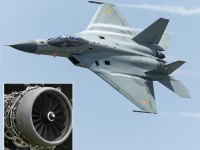- Views: 6K
- Replies: 55
Japan has officially offered its state-of-the-art IHI XF9-1 engine to India for co-development and domestic manufacturing, positioning it as a powerful contender to be the heart of the nation's Advanced Medium Combat Aircraft (AMCA).
The proposal makes Japan the fourth country to enter the high-stakes competition to supply the engine for India's futuristic 5.5-generation stealth fighter, joining established aerospace leaders from the United States, the United Kingdom, and France.
The engine at the center of the offer, the IHI XF9-1, is a low-bypass turbofan designed for high performance. Developed by Japan's IHI Corporation, the prototype engine produces a dry thrust of approximately 11 tons (107kN) and can achieve over 15 tons (147kN) with its afterburner engaged.
Critically, the engine is engineered for future growth, with a potential maximum thrust of nearly 20 tons (196kN), making it suitable not only for current but also for next-generation combat aircraft.
India's Gas Turbine Research Establishment (GTRE), the agency leading the engine project, has outlined a need for a powerplant that can generate up to 120kN of thrust.
A key requirement is the ability to achieve "supercruise"—sustained supersonic flight without the heavy fuel consumption of an afterburner—which requires a dry thrust of around 73-75 kN.
While the XF9-1's current dry thrust is higher than this, its modern design allows it to be modified or "detuned" to precisely meet the AMCA's immediate needs.
This scalability is a major advantage, as the same core engine could later be upgraded to power future sixth-generation variants that will demand significantly more power.
Competition for the AMCA engine contract is intense, with the Japanese offer now being weighed against proposals from other global giants.
These include the Safran M88 engine from France, the Eurojet EJ200 from a British-led consortium, and the F414 engine from General Electric in the United States.
Each offer is being evaluated on its technical merits, level of technology transfer, and alignment with India's strategic goals.
The Japanese proposal strongly supports India's "Make in India" initiative and the goal of achieving self-reliance in critical defence technologies. The offer includes provisions for the XF9-1 to be manufactured locally, which would provide a significant boost to India's aerospace and defence industrial base.
A partnership on such a crucial project would also mark a major milestone in the growing strategic and defence relationship between India and Japan.
As the AMCA program moves forward, the Indian Air Force and GTRE will conduct a thorough assessment of all proposals. The final decision will depend on a combination of factors, including engine performance, the extent of technology sharing, long-term costs, and strategic benefits.
Japan's entry highlights the global importance of the AMCA project and strengthens India's position as a rising power in the world of advanced aerospace engineering.


